"Build Kayaks!"
I have always tried to be able to 'do it myself', with a particular interest in keeping older skills alive. I am not sure it fits the definition here, but I think of it as a component of 'Resilience'...being able to do things for ourselves instead of relying on help, especially from far away. So, I have grown food, built houses, built railroads, built bridges, made my own musical instruments...maintain my own VW bus, pour concrete, and any number of other things I could rely on someone else to do for me. This essay is about how I have built a kayak.
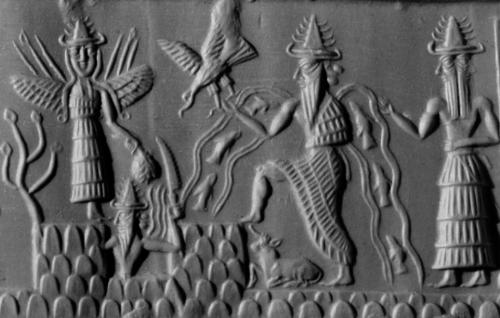
Around two years ago, just before waking up in the morning, I had a short dream. Enki, the Sumerian Water God (I didn't know that until I checked him out later) came to me in the dream, and said, "Every drought ends in a flood. Build kayaks."
Now, we live in Arizona, and had been in drought for a while, so I figured he might be on to something. I grew up in California, and have always loved the water. I learned to sail, to surf, and to canoe, and have done those for much of my life. But I had never been in a proper enclosed kayak. It was time to figure it out. I had been saving a catalog from a company that makes kits for wooden strip canoes, for many years. I dug it out, and sure enough, they had a few kayak models. A little research lead me to the knowledge that they were pretty heavy, and would take a very long time to finish. So I started looking at kits made of very thin marine plywood. I got more excited, and figured I could do this. But all that fiberglass, resin, sanding, dust masks, respirators! I had second thoughts.
Then I heard about skin-on-frame kayaks, designed by a guy named Tom Yost. His website went offline a year ago, which is really too bad. He had designs, plans, and instructions, all for free, for a great number of kayak designs. The basic idea was to build them like a model aircraft (which I had done hundreds of times), with plywood bulkheads to define the shape, and stringers to connect them together, and support the skin. Not only was this something I could do, but it was closer to the real origins of kayaks, with light wooden frames, covered with sewn animal skins. So I studied his designs, picked one, and set about modifying it to fit my large frame. My partner needed one too, of course...she had different criteria.
(That's not Sphinxmoth...I think that it is Dave Gentry's daughter, showing off one of his designs.)
Sphinxmoth wanted a kayak with a larger opening for the cockpit, for bird photography from the water. That led me eventually to Dave Gentry's website: http://gentrycustomboats.com/NewHomebuilderplans.html Gentry had taken Tom Yost's 'plans', which were actually tables of 'offsets'...numerical coordinates that defined the shape of a boat. Gentry turned those into actual plans, even templates to cut the shape of the bulkheads, which he could sell, with instructions. I later learned that one of my local friends had built one of his designs, and has since done two more. Gentry has great designs, and makes the process pretty easy. He had a boat (above) that fit the open cockpit design, that was the right size for Sphinxmoth to paddle herself, to be able to get the photos she wanted. Me, being a cheapskate, built a hybrid of his design grafted onto one of Yost's smaller kayaks, making the modifications myself. But I do highly recommend Gentry's plans to others.
I started building two kayaks at the same time, in the Bisbee Boatyard. Of course, I continued researching how to build kayaks, and came across an Instructable by Wolfgang Brinck, on how to build a Greenland kayak, from scratch. The real deal! Unfortunately, I was too far along in the process to go back now, but I was able to incorporate a lot of what he taught there, into my own kayak. I changed the spacing of the frames to accommodate my proportions, added a 'masik' to enable me to control the boat with my knees and hips, and learned about the decklines and toggles that the Greenland hunters used to store tools on the deck of their boat. Especially the carved animal figurines that they used for spacers, and to control the tension on the lines.
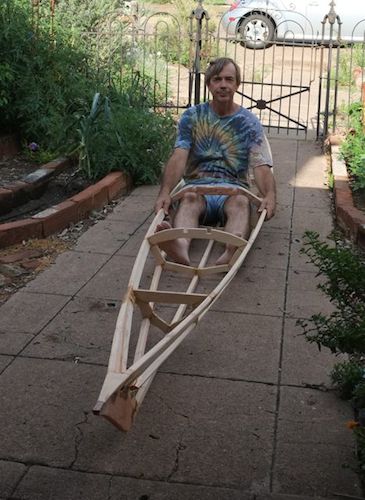
After the frame was complete, I covered it with some heavyweight ballistic nylon. The skin is wrapped over the bottom, and sewn tightly the length of the top of the boat, pulling tighter as it is sewn, to take the wrinkles out of the cloth.
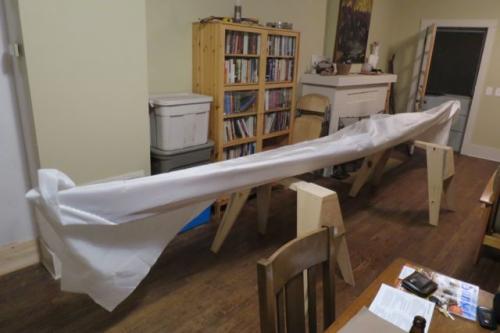
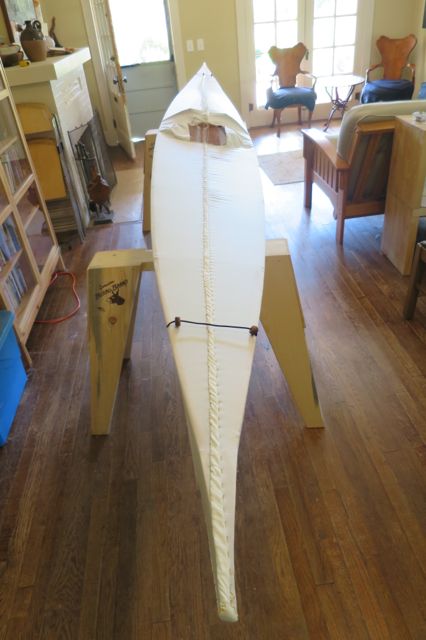
Once the skin is tight, and ironed, to take out remaining wrinkles, the messiest part is next. A kayak builder near Anacortes, WA, named Corey Freedman teaches classes on kayak building, and uses (and sells) a two part polyurethane that is supposed to be non-toxic (no off-gassing). It can be tinted with natural pigments. It is squeegeed into the weave of the fabric, and coated with three layers. It remains permanently flexible, and makes a good substitute for stretched animal skin. We're all out of seals here in Bisbee. A day or so after the skin was coated, we got our first rainstorm of the summer, and I was able to float-test the boats in a puddle.
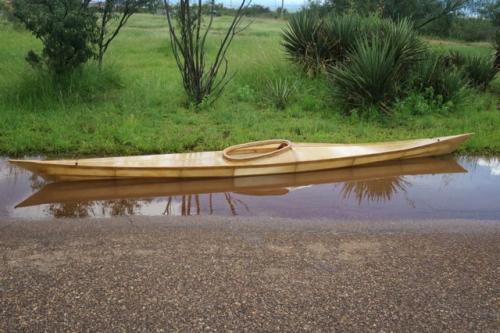
I added deck lines, and carved walnut 'toggles' in order to organize items on the deck (spare paddle, GoPro camera, etc.) Some of mine are shaped like caribou, and sphinxmoth's are little river otters.
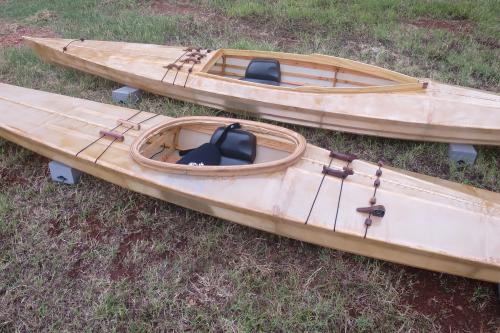
[video:https://www.youtube.com/watch?v=_r-74lcpQYI]
We have made several trips with them to (sort-of) local lakes, and they met their original design goals. Mine is sleek and fast, and Sphinxmoth's is stable and easier to maneuver, and put multiple cameras into the cockpit.
But, to her consternation, mine goes much faster with less effort. She wants a fast one. And mine has only room for my own body...no gear for a camping trip. And I want to make a trek by kayak, and camp out. Backpacking by boat. So I started another kayak for me, and am planning another one for her. This gave me a chance to go an even more traditional route. Both will have steam-bent ribs, instead of plywood bulkheads. Both will be tied together with lashings of 'artificial sinew' (waxed nylon twine). Hers will be shaped like a Greenland kayak...low, sleek, and fast. And mine will look like an Alaskan kayak from the Kodiak Island area, large enough to take off through surf and paddle in the Gulf of Alaska, and put a stove, tent, and sleeping bag inside. This one is also a replica, in the museum in Kodiak, and the model for mine.
I had even more help from Harvey Golden of the Lincoln Street Kayak & Canoe Museum, in Portland. He has built 80-odd traditional kayaks, written two huge books about them, and opened a museum to display them, answer questions, and give out advice. He gave me a precise drawing of a Sugpiaq kayak that he had measured in the Canadian Canoe Museum, and I used that to help build my kayak. It is now published in his most recent book, on Kayaks of Alaska. In addition to the complex bow, it has six chines (instead of the two on the Greenland kayak) to form the hull, each of them lashed with a complex knot to each of the 22 ribs, and the keel, and mortised into the gunwales. The deck crossbeams are also mortised, through the gunwales, and then lashed to it. The gunwales and keel are lashed to the bow and stern pieces, and further shaped by some (bent) deck boards near the bow.
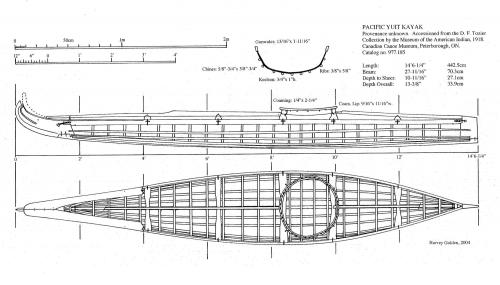
So, it has taken me longer, but it is finished. No metal fasteners were used. The pieces were cut out with saws, but then were all cut to their final shape with a 'crooked knife'. Alaskan kayaks have many varieties, depending on the tribal groups that built them, and their specific requirements, to meet local conditions. The people of Kodiak Island and Prince William sound were called 'alutiiq' by the Russians, and some still identify that way (notably Alutiiq artist and teacher Andrew Abyo), but some are now going by their older names, Chugach, Koniag, Sugpiaq. All are of the Yup'ik language group, different from the Inuit farther north (and all the way to Greenland), and from their Aleut neighbors. The Sugpiaq, as well as the Aleuts, developed distinctive bows for their kayaks, that act much like the modern innovation of bulbous bows on freighters, allowing the ship to move faster by changing the pattern of the waves made by the bow. They also cut through small chop better, and rise over larger waves better, then the more commonly copied Greenland kayaks, used in sheltered fjords.
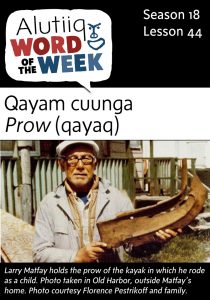

We don't have the traditional spruce stumps, here in Bisbee, to make the prow, so I glued up a large enough pine block to carve one from. The frame of the kayak was then built behind that, and lashed together. I heated and bent the ribs by hand (breaking, and rejecting, quite a few of them), but the resulting effect is similar to what I have seen in museums...uneven ribs coaxed into a smooth shape by the stringers, and the tension of the skin. I'll use a form to bend Sphinxmoth's, it's easier and looks better. Here is the finished frame, coated with 'simulated seals blood' (no seals here, remember...), a very traditional, even spiritual coating for the Sugpiaq.
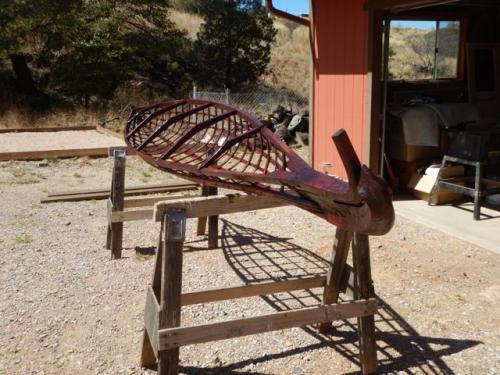
The cockpit rim is held in place by 'stanchions' (ayaperyarat) on each side. Yup'ik farther west (Nunivak Island) decorate them with faces...one female, one male...one happy, one sad. The idea is to provide balance to the kayak. It seemed like a good idea to me, so I added them to my otherwise Sugpiaq kayak.
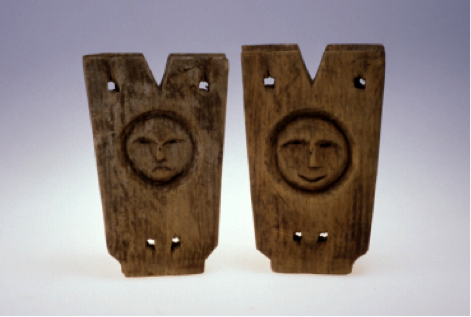
Yup'ik ayaperyarat from a museum in Anchorage
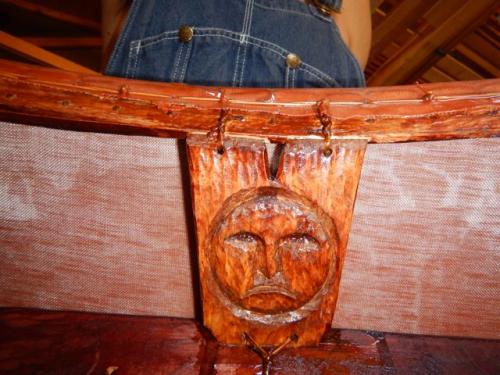
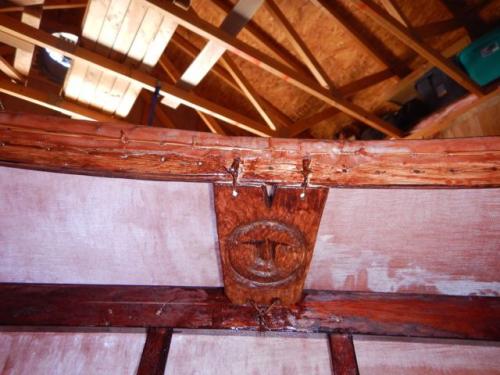
My own copies, installed in the kayak
The skin was installed the same way as the first two kayaks, but the sewing was much more difficult, because of the complex shape of the bow. The deck lines are much simpler...just three lines crossing the deck as grab lines, or to slide a spare paddle under.
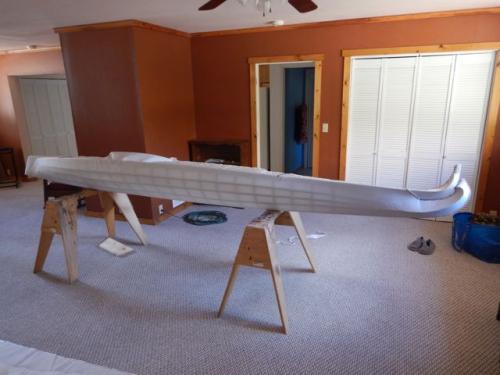
And then Corey's Goop was added, to seal the skin. First the bottom of the kayak, left for a day to dry:
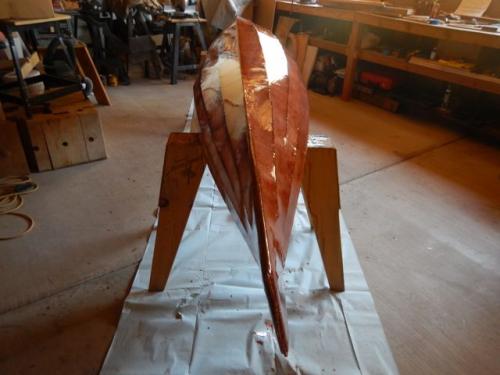
And today the top side. It's finished!
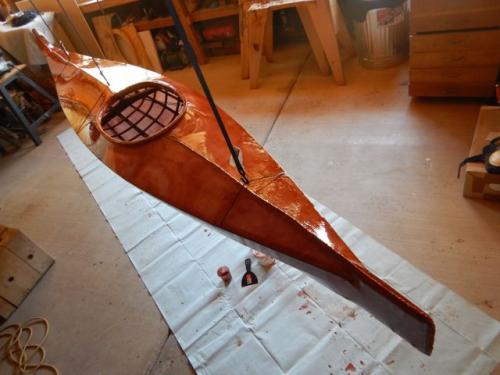
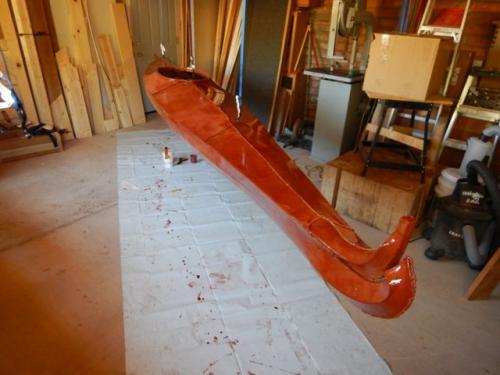
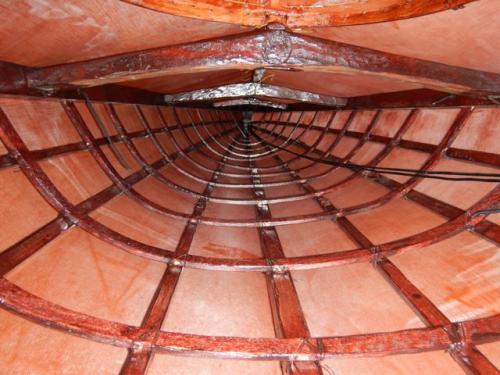
A view of the inside, looking forward, with my caribou emblem carved into the cross beam.
I can hardly wait to get it into the water.


Comments
This is the most gorgeous work I've seen in a very long time!
I'm speechless with admiration, Bisbo. Your craftsmanship is extraordinary. And the the depth of consciousness on display throughout filled me with wonder. The respect and the appreciation you show for First Nations skill and lore is an example. What a dream - and how it inspired you! I remember you talking about the kayak building and it is a real pleasure to see how it all came together.
Congratulations, mate. And thank you for sharing this project with us.
Resilience: practical action to improve things we can control.
3D+: developing language for postmodern spirituality.
this is a work of art
you could be in a film documentary. Am in awe! I made some curtains once...
Beautiful workmanship! n/t
"Intelligence is the ability to adapt to change." Stephen Hawking
NEW: http://www.twitter.com/trueblueinwdc
Amazing art!
I love kayaking! I think of it as meditating. I love going on on the lakes or rivers.
Your work is absolutely lovely and it's breath taking. Thank you for this eye candy and detail.
"Love One Another" ~ George Harrison
Thanks, folks.
I have always tried to do good work. And the building gets to be as much an adventure as the using.
"I’m a human being, first and foremost, and as such I’m for whoever and whatever benefits humanity as a whole.” —Malcolm X
Very cool!
Thank you for sharing this here, Bisbonian.
~ Be kind, for everyone you meet is fighting a hard battle. ~
I forgot that I had video
of launch day for the first two kayaks! I have incorporated it into the essay.
"I’m a human being, first and foremost, and as such I’m for whoever and whatever benefits humanity as a whole.” —Malcolm X
I recognize that lake in the video,
camped there many times. Very cool kayaks. Where are you guys planning to go kayak camping ?
We wanted decent healthcare, a living wage and free college.
The Democrats gave us Biden and war instead.
Hi Az!
We need to organize a meetup, THERE! I'll bring lots of boats. Three kayaks and a canoe and lots of life preservers.
I have a couple week stretch in August (going solo...spending a week or more tucked into a boat is not Spinxmoth's thing), and am planning on going from Shelton Washington, via Hope Island, Harstine Island, Nisqually Marsh, Vashon Island, and maybe Bainbridge Island, to West Seattle.
Although a quick Patagonia campout would make a nice shakedown cruise.
"I’m a human being, first and foremost, and as such I’m for whoever and whatever benefits humanity as a whole.” —Malcolm X
I'm game for a meet-up at the lake.
There's a couple of good camping spots there that are accessible by boat only. There's that island down by the dam and a really good spot on the north side of the lake. Might want to wait for Sept. or Oct. so it won't be so hot. Are you guys gonna' be around for the Fourth ?
P.S. I hate you for your productivity.
We wanted decent healthcare, a living wage and free college.
The Democrats gave us Biden and war instead.
I have no productivity!
I spend all my time playing with boats!
I vote for September. Greener than green, and the crowds have gone home. I am familiar with those campsites...Sphinxmoth and I camped at one once, using the canoe to haul our stuff. She got a new (1965) trailer recently, though, and will want to use that. The regular campground can be nice, if there aren't many people there.
"I’m a human being, first and foremost, and as such I’m for whoever and whatever benefits humanity as a whole.” —Malcolm X
Wow!!
Impressive craftsmanship.
Gëzuar!!
from a reasonably stable genius.
Thanks, BR
I was reading annieli's essay about Marxists on Mars, and realized that, like William Morris, I have always admired actual craftsmanship, rather than cranked out mass produced goods. And have long been a fan of the Arts and Crafts movement. So you hit on a favorite word of mine.
"I’m a human being, first and foremost, and as such I’m for whoever and whatever benefits humanity as a whole.” —Malcolm X
Well your craftsmanship really deserves a double Wow!!
Making/building something to completion and seeing it work really is a wondrous thing/feeling.
Something you can't buy.
Gëzuar!!
from a reasonably stable genius.
Aren't they called 'bardaikus'
or some such? Wooden Boat Magazine had/has several articles on these and other tips for wooden kayaks. Skin on frame designs, strip boats and many others. A very good resource from the Maine coast.
Great work btw. How is the stability under full camping load through surf? Man! So many questions!
Ya got to be a Spirit, cain't be no Ghost. . .
Explain Bldg #7. . . still waiting. . .
If you’ve ever wondered whether you would have complied in 1930’s Germany,
Now you know. . .
sign at protest march
'Baidarka' is a Russian word, which means 'small boat'.
So, not only does that leave a lot of room for confusion with other small boats, it was what the Russians called the boats of the people that they literally enslaved to hunt fur seals and sea otters for them, to the brink of extinction. So I don't like the word. Inuit and Yup'ik people used the word 'qayaq', which essentially means 'covered', as opposed to an open boat like a canoe, or an umiak (a larger, open skin boat, family sized). The Aleut (Unangan) word looks a lot different, but you can hear the similarity. 'Iqyax'
I just finished putting on the coating a few hours ago, so haven't gotten to try it out yet...the design is said to work well in surf. The Aleuts and Alutiiq both put big rocks in their kayaks, as ballast, to keep them upright. I plan to use camping gear in the same way, and suspect it will work pretty well.
Here is one of Harvey Golden's, playing in the surf toward the bottom of the page.
"I’m a human being, first and foremost, and as such I’m for whoever and whatever benefits humanity as a whole.” —Malcolm X